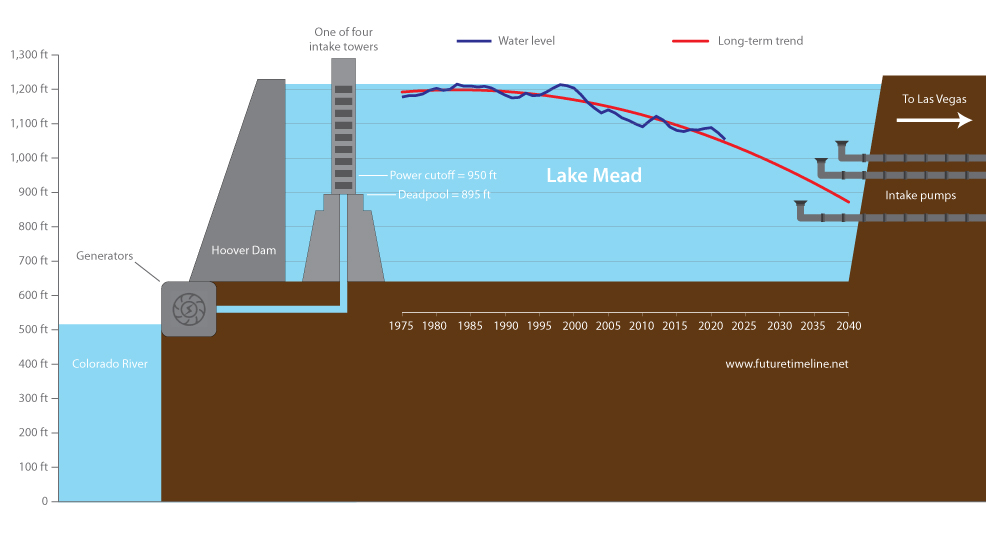
|
|
|
|
|
|
2033-2035
Quantum computers are cracking RSA-2048 keys
By now, quantum computers are becoming so powerful – and with such long coherence times – that they can unlock previously high-level encryption with hundreds of digits in a matter of seconds.
Quantum computers began to emerge in the previous decade as a revolutionary alternative to "classical" computers. While the latter had been restricted to binary ones and zeros, quantum systems had the advantage of using multiple values simultaneously, allowing them to work with astronomically huge numbers that would ordinarily take millions or billions of years to calculate.
During the 2010s, the most powerful quantum computers featured several tens of qubits – the quantum equivalent of computer bits – making them inferior to traditional computers. Companies such as D-Wave had claimed thousands of qubits but relied on a technique called quantum annealing, not accepted by researchers as "universal" quantum computers and prone to high error rates.
While a rapid scaling up of qubits occurred in the 2020s, coherence times remained a big challenge. Defined as how long a qubit can hold accurate information, this had typically been measured on timescales of nano- or microseconds. However, quantum computers began to exceed coherence times of one second or more by the end of the decade.
In the 2030s, coherence times increased still further, with stable and uninterrupted calculations of 10 seconds or more.* The combination of increasingly coherent and fault-tolerant systems* and even higher qubit counts* now enabled quantum computers to work with truly gigantic numbers. This included solving high-level encryption algorithms.** It would take classical computers 300 trillion years to break the 617 digits of the RSA-2048 standard, for example. Researchers with quantum computers now achieved this feat in 10 seconds.
By the mid-2030s,* with large-scale quantum computers moving from the laboratory and into wider use, the vast amounts of computational power available are providing many opportunities but also dangers. While most governments and businesses have taken measures to upgrade their IT infrastructure, legacy systems without the required security improvements are now vulnerable to cyberattacks by state actors and organised criminals.
In addition to users' personal data, the ability to crack RSA-2048 keys also reveals state and industrial secrets, and information pertinent to long-standing conspiracy theories, historical archives, and so on. News media reports of this time highlight a number of breaches and leaks, prompting greater scrutiny of quantum computer technology and encryption in general.

2033
Crewed mission to Phobos
In 2033, NASA conducts the first crewed mission to Phobos, the innermost and larger of the two natural satellites of Mars. This is the latest in a series of ambitious new targets to expand the human exploration of space. Previous missions had seen astronauts returning to the Moon and constructing a new space station in lunar orbit. This latest mission – over 60 years after the Apollo era – involves orbiting Mars first, before landing on the surface of Phobos.
While the average distance to the Moon is 384,000 km (239,000 miles), a journey to Mars is nearly 600 times further, at 225 million km (139 million miles) and poses major technical and financial challenges. However, going to Phobos before Mars itself is less expensive and lower risk, while allowing NASA to demonstrate key technologies for the more advanced missions later on.
When used in near-Earth space, the Multi-Purpose Crew Vehicle (MPCV) is capable of carrying four astronauts on 21-day missions. For journeys to more remote destinations requiring months of travel, such as Mars, it can be attached to other modules with longer-term consumables and support capabilities. Astronauts are able to manoeuvre around the low gravity environment of Phobos using jetpacks and other equipment, while collecting samples and performing a variety of science experiments. This "orbit first" mission serves as a precursor to landings on Mars itself in the late 2030s and early 2040s.*
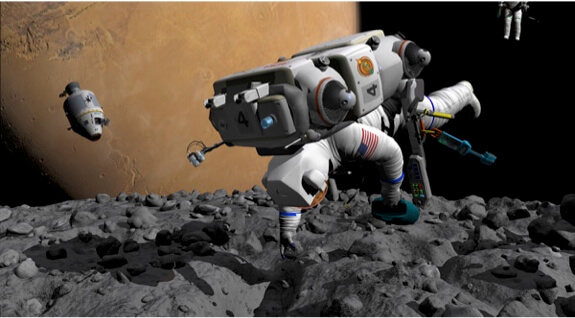
Phobos 2033 crewed mission. Credit: NASA
Peak phosphorus is reached
Phosphorus is a basic building block of life, playing a vital role in the structural framework of DNA and RNA. Found in the cell membranes of animals and plants, it is essential for the transfer of energy. A main component of fertilisers, it helps plants to survive temperature changes, water changes and water deficiencies. This chemical is fundamental to the modern growing of crops.
Phosphorus is a scarce and finite resource on Earth, and due to its non-gaseous environmental cycle it cannot be replaced by anything else. For a long time, this problem was largely overlooked by governments – most of whom took a complacent attitude, assuming that this mineral would be around for centuries or more. It was rarely viewed as a political issue, with most talk about the chemical being focussed on its polluting effects, rather than its potential scarcity.
New studies in the 2000s and early 2010s, however, revealed that supplies were dwindling much faster than had previously been thought. This trend was being accelerated by emerging economies such as China and India – countries in which there was ever-increasing demand for meat and dairy products, which correspondingly required more and more phosphorus to produce. By 2033, worldwide production of phosphorus has peaked.**
The immediate impact is an alarming increase in the price of food, as well as government nationalisation of phosphate reserves and the introduction of export tariffs. Some regions undergo famines, while others are forced to introduce emergency rationing. Food prices have also doubled due to climate change, adding further woe.*
Richer nations are better prepared for this crisis – but nevertheless, many have experienced a significant period of readjustment with new methods being mandated and deployed to capture, store and recycle phosphorus. Among the most widely-used short-term innovations is recycling of human urine (a phosphate-rich substance), although this is only a temporary solution.* The extracting of phosphorus from the seabed is another development being looked at, but presents major technological and financial challenges.
With global population continuing to climb rapidly, the race is now on for longer-term fixes to provide genuine alternatives that can actually replace phosphorus.
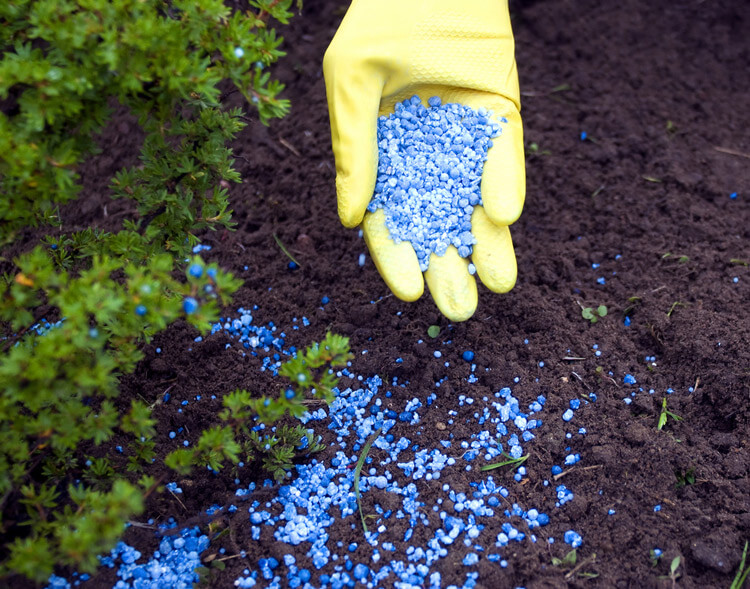
Hypersonic airliners are entering service
Following decades of research and development, a new generation of aeroplanes is entering commercial service.* These aircraft have a cruising speed of Mach 5 – or about 3,800 mph – enabling them to fly from Europe to Australia in less than four hours. With a range of more than 20,000km (12,000 miles) they can perform this journey without refuelling and have excellent subsonic and supersonic fuel efficiency, thus avoiding the problems inherent in earlier supersonic aircraft.
Another advantage is that, while the 150 metre-long designs are bigger than previous jets, they are actually lighter than Boeing 747s and can utilise conventional runways. They have moderate take-off noise, too. In many ways, they are the spiritual successor of Concorde.
They lack windows, however. The heat generated by traveling so fast makes it difficult to install windows that are not too heavy. One solution to this problem has been the installation of flat screen displays, showing images of the scene outside.
The final phase of Britain's HS2 rail link is completed
High Speed 1 (HS1), also known as the Channel Tunnel Rail Link (CTRL), was a 108 km (67 mi) high-speed rail line, running from London to the British end of the Channel Tunnel. Completed in 2007, this route into continental Europe had only a single operator at the time – Eurostar, which provided trains to Paris, Brussels and seasonal destinations in southern France. Additional services became available in the 2010s, allowing direct high-speed rail from London to Frankfurt and Amsterdam.
The development of high-speed rail sparked further interest and debate in Britain and was supported in principle by the three main political parties. Detailed plans were drawn up for a domestic network, linking together some of the nation's largest commuter cities. Though much controversy surrounded which cities should be served, as well as the environmental performance and impact,* the plans were finally approved in January 2012.*
High Speed 2 (HS2) would connect London with the Midlands and the North of England. It would be developed by High Speed Two Ltd, a company established by the government. The planned route took the form of a "Y" shape, with a central trunk going from London to England's next largest city, Birmingham, which then forked into two spurs: one to Manchester and the other to Leeds.
HS2 was built in stages, the London to Birmingham section being the first, with construction starting in 2016 and the first trains running by the mid-2020s. There would be no intermediate calling points: trains would travel directly between London and Birmingham at speeds of 400 km/h (250 mph), cutting the journey time from 1 hour 24 minutes to just 49 minutes.
By 2033, the Manchester and Leeds branches are completed. Journey times from London to Manchester are reduced from 2 hours 8 minutes to 1 hour 20 minutes. Journeys from London to Leeds are reduced from 2 hours 20 minutes to 1 hour 20 minutes. Additional high-speed lines to Newcastle, Edinburgh and Glasgow are now being planned.
The total cost of the project is over £32 bn ($49 bn), making it the UK's largest rail expansion in almost a century. Congestion is greatly relieved on other networks and there are significant economic benefits, with over a million new jobs created. As part of the plans, Euston station in London is fully redeveloped and there is also a connection running to Heathrow airport, one of the world's busiest aviation hubs.*
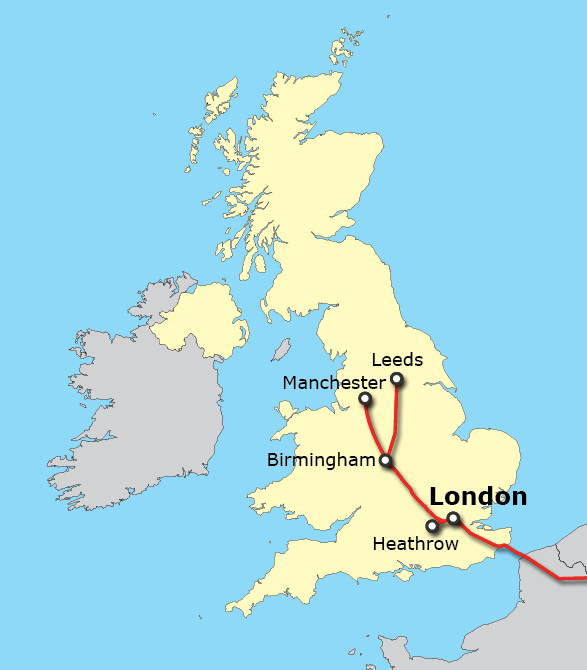
High-speed rail begins in California
The California High-Speed Rail line is a major transportation project to modernise the rail routes on the west coast of the United States, making them fit for the 21st century. This includes the country's fastest ever trains, capable of speeds up to 220 mph (354 km/h). The previous fastest, running between Boston and Washington, D.C., could only manage a top speed of 150 mph (241 km/h), with average speeds much lower.
Plans for high-speed rail in California had been discussed publicly since the 1970s. But ongoing legal battles, delays, and cost overruns sparked frequent concerns about the feasibility and timeline of such a project. In 1996, Senate Bill 1420 created the California High-Speed Rail Authority (CHSRA) to oversee and develop the concept further. In 2008, a majority of California voters approved Proposition 1A, authorising the state to issue nearly $10 billion in bonds to fund the CHSRA. Construction on part of the line began in 2015, with a groundbreaking ceremony in Fresno.
This first major section – a 171-mile route from Merced to Bakersfield in the Central Valley – finally enters commercial service in 2033.* The Authority originally aimed for 2030, later revised to 2031, but persistent construction delays, third-party disputes, and funding challenges forced the timeline back yet again. Oversight reports by the Office of the Inspector General highlighted the growing risks and described the earlier schedule as unrealistic.
Separately to this, a privately run line called Brightline West has been developed by now, connecting the LA metro area and Las Vegas with trains running at up to 186 mph (300 km/h). That line began service in 2028, bringing high-speed rail to the Western USA several years before the Merced–Bakersfield section.
The northern and southern parts of the California High-Speed Rail line still face delays and budgetary constraints. However, with many people now experiencing what the fully realised version can offer – and the urgent need for low- or zero-carbon transport – these remaining sections of the project have become an increasingly important political issue.
When finished, this network will connect all of the state's major economic centres, totalling 800 miles and 24 stations, with high-speed routes from San Francisco and Sacramento, through the Central Valley, down to Los Angeles, and even as far as San Diego. A journey that once took six or seven hours by car, such as from San Francisco to Los Angeles, will be possible in less than 2 hours 40 minutes.*
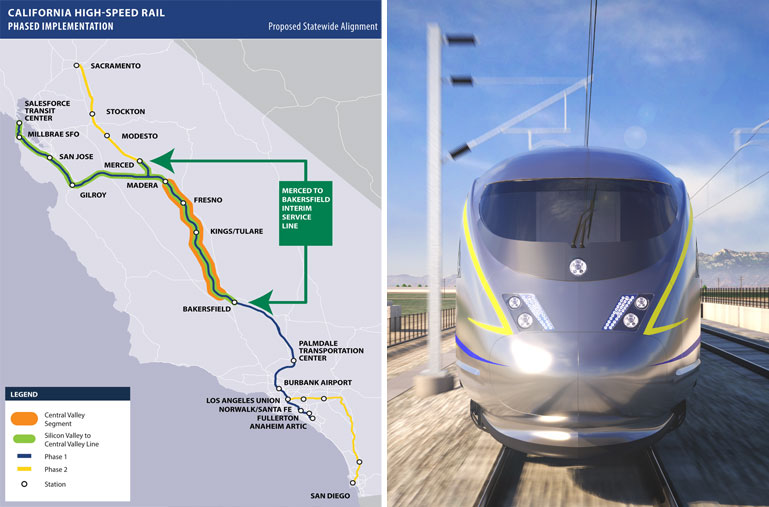
The largest ever hydropower dam becomes operational in China
Following the Chinese Communist Revolution of 1949, China initiated a program of dam construction. However, most of these dams were built for irrigation and not intended to produce electricity. Moreover, unskilled peasants carried out most of the construction. During this period, a steady supply of cheap domestic coal hindered the development of hydroelectricity. The installed capacity of hydroelectric plants increased after the 1960s, with projects of larger size and complexity, reaching a total of 20 GW by 1980.
In the 1980s and 1990s, projects such as the Xiaolangdi and Gezhouba dams paved the way for a national hydropower revolution. The 2000s witnessed the construction of the Three Gorges Dam – a symbol of China's emerging engineering prowess and renewable energy ambitions. At 2.3 km in length and with an astonishing 22.5 GW of capacity, it dwarfed all previous projects.
China had even grander aspirations, however. In the early 2020s, authorities unveiled the Medog Hydropower Station proposal* on the lower reaches of the Yarlung Tsangpo River in Tibet. Designed to generate 60 GW of power and produce 300 billion kilowatt hours annually, this monumental project would push the boundaries of human engineering, setting a new benchmark as the world's largest hydropower installation.
Engineers harnessed a dramatic 2,000-metre elevation drop over a 50-kilometre river stretch and carved four 20-kilometre tunnels through the formidable Namcha Barwa mountain. They worked within the breathtaking and challenging terrain of the Yarlung Tsangpo Grand Canyon, Earth's deepest canyon system, confronting seismic instability and landslide risks along the way. The project demanded rigorous environmental assessments and the most advanced construction techniques to ensure safety and efficiency.
Chinese officials authorised the station with an investment exceeding 1 trillion yuan (US$137 billion), quadruple that of the Three Gorges Dam. The project would operate as a single-phase installation and stand as a keystone in China's drive to secure carbon neutrality and stimulate economic development in the Tibet Autonomous Region.
At the same time, local communities and environmental groups criticised the project for its potential to displace residents, impact local biodiversity, and disrupt culturally significant sites. Downstream nations, including India and Bangladesh, scrutinised the dam's impact on their water resources, since the river transformed into the Brahmaputra upon leaving Tibet. Indian authorities actively explored their own hydropower solutions and reservoir systems to counter any adverse effects, as the project further inflamed simmering disputes over regional water politics.
In 2033, the Medog dam comes online,* marking a major milestone in China's renewable energy journey. As it begins to energise the region – powering a total of 50 million homes – it not only reshapes the energy landscape of the Tibetan Plateau but also redefines the balance of water resources in South Asia for many decades to come.
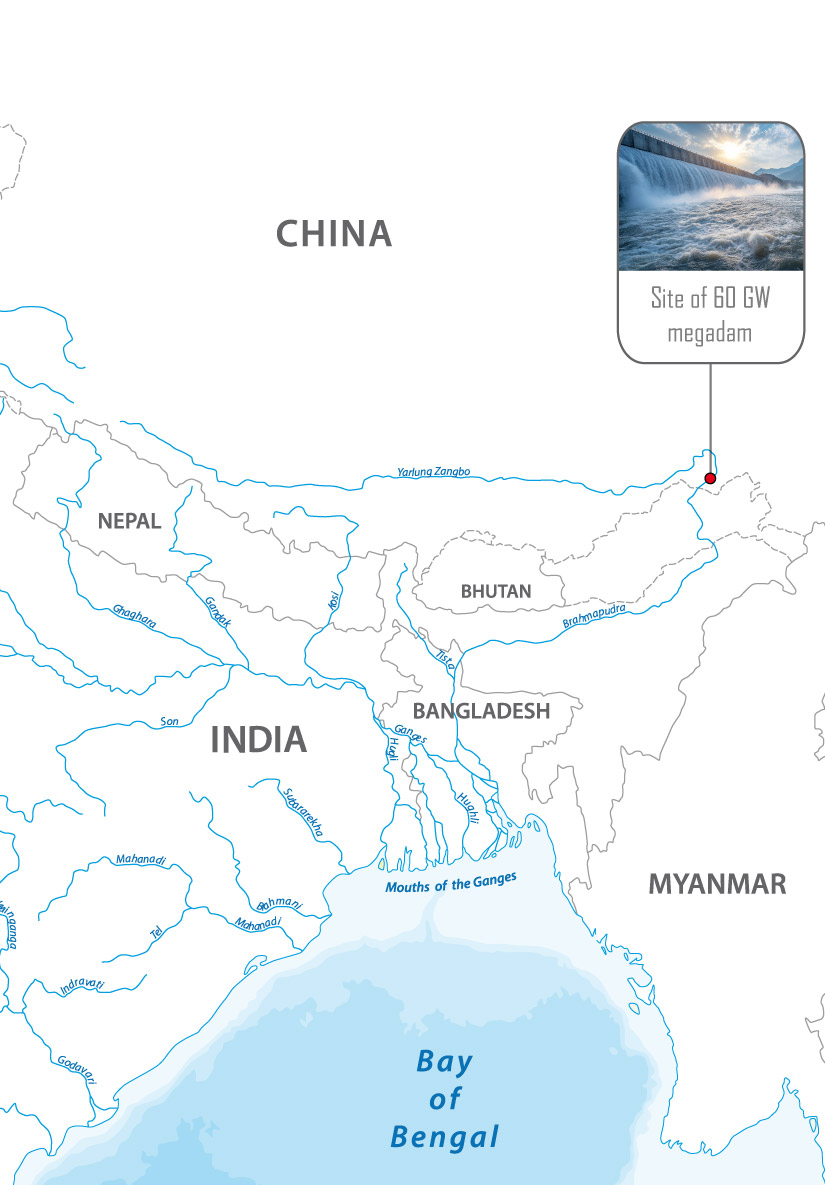
The Hoover Dam is offline due to low water levels
From 1936 until 1948, the Hoover Dam held the title of largest hydroelectric plant in the world. An engineering marvel, its completion also involved the creation of Lake Mead, the largest artificial reservoir in the United States. At maximum capacity, it contained 28.23 million acre-feet of water, providing sustenance to nearly 20 million people and large areas of farmland in the states of Arizona, California, and Nevada as well as some of Mexico.
From 1983 onwards, the lake remained below its full capacity owing to drought and increased water demand. As of 2022, it held just 26.6% of its maximum, dropping below the reservoir's previous all-time low. Changing rainfall patterns, reduced snow melt runoff, and growing demand for water placed increasing pressure on the management of resources at Lake Mead.*
Engineers retrofitted the dam with new turbines, designed to work more efficiently and reducing the minimum lake level necessary to generate electricity from 1,050 feet (320 m) to 950 feet (290 m). Alongside this, a new intake pump at a lower depth guaranteed the flow of water to nearby Las Vegas.*
However, these would prove to be only temporary solutions, as water levels continued to drop, even with conservation measures. The Hoover Dam had already lost 30% of its power between 2000 and 2020. By 2033, the lake has fallen below the lower limit for electricity generation.* It now appears on course to reach two further milestones before 2040. Firstly, the "deadpool" of 895 feet – the point at which no water can be released from the dam into the Colorado River. Secondly, the even lower depth of Lake Mead's third intake pump at 875 feet, which supplies water to Las Vegas.
Additional problems are occurring further upstream. To the east is Lake Powell, the second largest reservoir in the country, which has been experiencing its own water shortages too.* The issues in that region are exacerbating those of Lake Mead.* The decline of both reservoirs has presented serious challenges in terms of electricity demand, municipal water use, and irrigation, affecting a combined total of more than 40 million people. Many more water-related crises are emerging around the country at this time, due to worsening climate change and insufficient long-term planning.
Click to enlarge
Data source: U.S. Bureau of Reclamation
The first samples from Mars are returned to Earth
In February 2021, NASA's Perseverance rover landed in Jezero Crater on Mars. Studies indicated this 49 km (30.4 mi) diameter crater contained a lake in the distant past, reaching as deep as 250 m (820 ft). A fan-delta deposit rich in clays showed that the lake existed when valley networks formed on Mars, making it a geologically rich site.
The rover's goals included looking for ancient Martian environments able to support life, seeking evidence of former microbial life existing in those environments, collecting rock and soil samples, and testing oxygen production from Mars' atmosphere to prepare for future crewed missions. To accomplish all this, it carried seven primary payload instruments, 19 cameras, and two microphones. A mini-helicopter called Ingenuity performed aerial scouting ahead of the rover to seek areas of interest for possible examination.
Initially, the rover explored the crater's floor, studying igneous rock. It later investigated sedimentary rocks of the accompanying delta, formed when particles of various sizes settled in the once-watery region. In September 2022, the rover identified a strong signal of organic matter – the building blocks of life and a potential biosignature – in the highest concentration yet seen during its mission.*
Perseverance had capacity for up to 43 samples, obtained via its Sample Caching System. Built using more than 3,000 individual parts, NASA described this automated device as "the most complicated, most sophisticated mechanism that we have ever built, tested and readied for spaceflight." After being filled, each of the sample tubes would be hermetically sealed to ensure that its contents survived for an indeterminate amount of time on the Martian surface and withstood the eventual return to Earth. The seal had to be made without contaminating the sample, so no adhesives or heat could be used.
Following the Perseverance rover, two other missions arrived at Mars later in the decade: an Earth Return Orbiter (ERO) and Sample Retrieval Lander (SRL), launched in 2027 and 2028, respectively. The SRL carried a small rocket (the Mars Ascent Vehicle), a robotic arm, and two helicopters similar to Ingenuity providing a secondary capability for retrieving the cached samples. After touching down nearby and being rendezvoused with Perseverance, the SRL used its robotic arm, developed by the European Space Agency (ESA) to place each tube aboard the Mars Ascent Vehicle before its blast off into space – the first rocket to ever launch from the surface of another planet. The orbiting ERO, also developed by ESA, then captured and enclosed the samples inside a highly secure containment capsule (the Earth Entry System), before making the 140 million mile (225 million km) journey back home.
Today, in 2033, these samples are finally being returned to Earth,* almost 13 years after the launch of Mars 2020. Obtaining samples from the Martian surface has been a dream of scientists for decades. The rocks and soil can be analysed in far greater detail with specialised laboratory equipment on Earth, as opposed to using the rover's more limited instruments.
Starlink's 42,000-satellite constellation is complete
By 2033, SpaceX has finished deploying the last of the 42,000 satellites* allotted under its Starlink project filings. Designed to deliver global broadband Internet from low-Earth orbit, Starlink is by far the largest satellite communications network in history. This milestone marks the culmination of a fourteen-year rollout that began in November 2019, when the company launched its first operational batch of 60 satellites aboard a Falcon 9. In the early years, Falcon 9 remained the sole workhorse for the constellation, lifting hundreds of missions and thousands of satellites – peaking at over 2,000 new units per year by the mid-2020s.* However, its limitations in volume and mass became increasingly apparent, especially as the demand for higher-bandwidth services grew.
A turning point arrived in the second half of the 2020s, when SpaceX's massive Starship rocket – now demonstrating consistent reliability – began launching the full-sized, next-generation Starlink V3 satellites. These offered 1 Tbps of downlink speeds and 160 Gbps of uplink capacity, more than 10x the downlink and 24x the uplink capacity of the previous V2 Mini satellites.*
Starship's payload bay could accommodate up to 54 of these larger spacecraft at once, delivering more than 50 terabits per second per launch, or 20 times the capacity of a Falcon 9 flight. Over the next several years, launch cadence steadily increased, reaching two flights per week.
The change has been palpable by the early 2030s, transforming global connectivity. High-speed internet is now available on remote islands, in mountain villages, polar expeditions, offshore platforms, and even mid-ocean flights. Emergency responders carry suitcase terminals that can restore communications within minutes of arrival. A Direct-to-Cell layer, compatible with ordinary smartphones and offering 4G-equivalent service – with upgrades to 5G in many regions – provides seamless mobile coverage without terrestrial towers, eliminating so-called mobile "dead zones." A reserved share of bandwidth supports scientific research and humanitarian aid. While China's Guowang system and other constellations compete for market share, Starlink maintains the largest and most capable satellite broadband network in orbit.
Yet this achievement has stirred ongoing debate. Astronomers struggle to minimise the effect of satellite trails in long-exposure images and increasingly rely on real-time tracking software to mask the interference. Concerns over space debris have intensified as low-Earth orbit grows more crowded than ever. In response, SpaceX has equipped each V3 satellite with autonomous collision-avoidance software and reliable de-orbit systems, while sharing ephemeris data with global space traffic coordination agencies. Some observers also question the risks of concentrating so much Internet infrastructure under a single private entity, particularly in underserved or politically sensitive regions.
By the close of 2033, Starlink stands as both a triumph of private spaceflight and a symbol of new responsibilities in orbit. Its sheer scale accelerates the development of stricter debris mitigation rules and lays the groundwork for new international space traffic management treaties. The vast network not only brings billions of people online – it also reshapes the rules for how humanity uses and protects near-Earth space.

« 2032 |
⇡ Back to top ⇡ |
2034 » |
If you enjoy our content, please consider sharing it:
References
1 Quantum coherence times, 2000-2040, Future Timeline:
https://www.futuretimeline.net/data-trends/18.htm
Accessed 5th April 2021.
2 Forecasting timelines of quantum computing, Jaime Sevilla and C. Jess Riede, arXiv.org:
https://arxiv.org/pdf/2009.05045.pdf
Accessed 5th April 2021.
3 New device for scaling up quantum computers, Future Timeline Blog:
https://www.futuretimeline.net/blog/2021/02/11-quantum-computers-future-timeline.htm
Accessed 5th April 2021.
4 Daniel J. Bernstein, PhD, mathematician, cryptologist, and computer programmer:
"I've recently bet $2,048 that the RSA-2048 challenge will be publicly factored by a quantum computer by 2033."
See Quantum algorithms to find collisions, The cr.yp.to blog:
https://blog.cr.yp.to/20171017-collisions.html
Accessed 5th April 2021.
5 Threat to current public-key cryptosystems in the next 15 years: [...] "Half (11/22) of the respondents indicated "about 50%" likely, or more likely."
See Quantum Threat Timeline, Global Risk Institute:
https://globalriskinstitute.org/publications/quantum-threat-timeline/
Accessed 5th April 2021.
6 "The RAND Corporation [...] expect quantum computers capable of breaking cryptographic protocols to be available between 2033-2035."
See
The impacts of quantum computing on insurance, Lloyds:
https://lloydslab.com/wp-content/uploads/Quantum-Paper.pdf
Accessed 5th April 2021.
7 SLS manifest options aim for Phobos prior to 2039 Mars landing, NASA Spaceflight:
https://www.nasaspaceflight.com/2015/09/sls-manifest-phobos-mars-2039/
Accessed 8th November 2016.
8 Peak Phosphorus: A Potential Food Security Crisis, Tariel Mórrígan, University of California:
http://www.global.ucsb.edu/climateproject/publications/pdf/Morrigan_2010_Peak%20Phosphorus.pdf
Accessed 23rd February 2018.
9 A rock and a hard place: Peak phosphorus and the threat to our food security, The Soil Association:
https://www.soilassociation.org/media/4348/a-rock-and-hard-place-phosphorus-report.pdf
Accessed 23rd February 2018.
10 Rising food prices increase squeeze on poor – Oxfam, BBC:
http://www.bbc.co.uk/news/world-13597657
Accessed 18th December 2011.
11 Scientists warn about food shortage in 2033, Schrödingers Katt (YouTube):
http://www.youtube.com/watch?v=ZzxowdYh22U
Accessed 18th December 2011.
12 Reaction
Engines A2, Wikipedia:
http://en.wikipedia.org/wiki/Reaction_Engines_A2
Accessed 10th October 2009.
13 High-Speed Rail Link Plans Build Up Steam, Sky News:
http://news.sky.com/home/business/article/16144165
Accessed 7th January 2012.
14 HS2: High-speed rail link 'being seriously considered', BBC:
http://www.bbc.co.uk/news/uk-16453869
Accessed 7th January 2012.
15 High Speed 2, Wikipedia:
http://en.wikipedia.org/wiki/High_Speed_2
Accessed 7th January 2012.
16 California High-Speed Rail, Wikipedia:
https://en.wikipedia.org/wiki/California_High-Speed_Rail
Accessed 8th September 2025.
17 California moves forward with high-speed rail plans, Future Timeline Blog:
https://www.futuretimeline.net/blog/2023/09/12-california-high-speed-rail-timeline.htm
Accessed 8th September 2025.
18 The INSANE Scale of China's $137BN Mega Dam in the Himalayas, YouTube:
https://www.youtube.com/watch?v=i-ShOGTbK-Q
Accessed 12th February 2025.
19 Power plant profile: Medog Project, China, Power Technology:
https://www.power-technology.com/marketdata/power-plant-profile-medog-project-china/
Accessed 12th February 2025.
20 The Colorado River drought is the first climate disaster the U.S. legally has to deal with, GRID:
https://www.grid.news/story/climate/2022/07/25/the-colorado-river-drought
Accessed 31st August 2022.
21 Lake Mead Intake Hydraulic Tunnel, USA - Webuild Project, YouTube:
https://www.youtube.com/watch?v=96mpc0UxuZk
Accessed 31st August 2022.
22 Deadpool at Hoover Dam, Sky Lights:
https://sky-lights.org/2021/10/04/deadpool-at-hoover-dam/
Accessed 31st August 2022.
23 Lake Powell Still Shrinking, NASA Earth Observatory:
https://earthobservatory.nasa.gov/images/150249/lake-powell-still-shrinking
Accessed 31st August 2022.
24 Las Vegas turns on low-level Lake Mead pumps designed to avoid a 'Day Zero', The Nevada Independent:
https://thenevadaindependent.com/article/las-vegas-turns-on-low-level-lake-mead
Accessed 31st August 2022.
25 NASA Breakthrough as Rover Finds Strong Signal of Organic Matter on Mars, Science Alert:
https://www.sciencealert.com/nasa-breakthrough-as-rover-finds-strong-signal-of-organic-matter-on-mars
Accessed 17th September 2022.
26 NASA Will Inspire World When It Returns Mars Samples to Earth in 2033, NASA:
https://www.nasa.gov/press-release/nasa-will-inspire-world-when-it-returns-mars-samples-to-earth-in-2033
Accessed 17th September 2022.
27 SpaceX may want to launch 42,000 internet satellites — about 5 times more spacecraft than humanity has ever flown, Business Insider:
https://www.businessinsider.com/spacex-starlink-internet-satellites-itc-filing-30000-additional-42000-total-2019-10
Accessed 7th May 2025.
28 List of Starlink and Starshield launches, Wikipedia:
https://en.wikipedia.org/wiki/List_of_Starlink_and_Starshield_launches
Accessed 7th May 2025.
29 SpaceX Teases 1Tbps of Download Bandwidth on V3 Starlink Satellites, PC Mag:
https://uk.pcmag.com/networking/156088/spacex-teases-1tbps-of-download-bandwidth-on-v3-starlink-satellites
Accessed 7th May 2025.
![[+]](https://www.futuretimeline.net/images/buttons/expand-symbol.gif)
